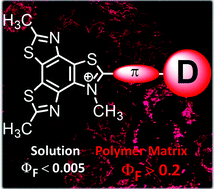Spectral properties of ionic benzotristhiazole based donor–acceptor NLO-phores in polymer matrices and their one- and two-photon cellular imaging ability†
Abstract
A series of ionic benzotristhiazolium (BTT) push–pull chromophores, with different nitrogen donor groups and different lengths of conjugated bridges, was successfully doped in polar polymer matrices (PVC and PSS). The spectral (photophysical) properties of their low concentration thin polymeric films are compared with those in solution and are discussed in terms of matrix polarity/viscosity influence, specific polymer–chromophore interaction, structure–spectral property relationship and Twisted Intramolecular Charge-Transfer (TICT) state formation. The elimination of a non-emissive phantom and TICT state formation by restricted intramolecular rotations in the polymer matrix or viscous solvent results in a relatively high ΦF of all the investigated NLO-phores; particularly for near-infrared NIR molecular rotors bearing diphenylamino and julolidine donor groups. Because of cationic characteristics, small molecular weight, calculated high second hyperpolarizability and significant emission efficiency dependence on surroundings’ viscosity (rigidochromic effect), two dyes were chosen as candidates for potential fluorescent probes for one-photon (1P) and two photon (2P) cellular imaging. The selected BTT NLO-phore with a julolidine donor is promising as a mitochondria-specific fluorescent small molecular probe for live cell super-resolution imaging with low cytotoxicity and good photostability, and is also potentially suitable for super-resolution STED imaging.



 Please wait while we load your content...
Please wait while we load your content...